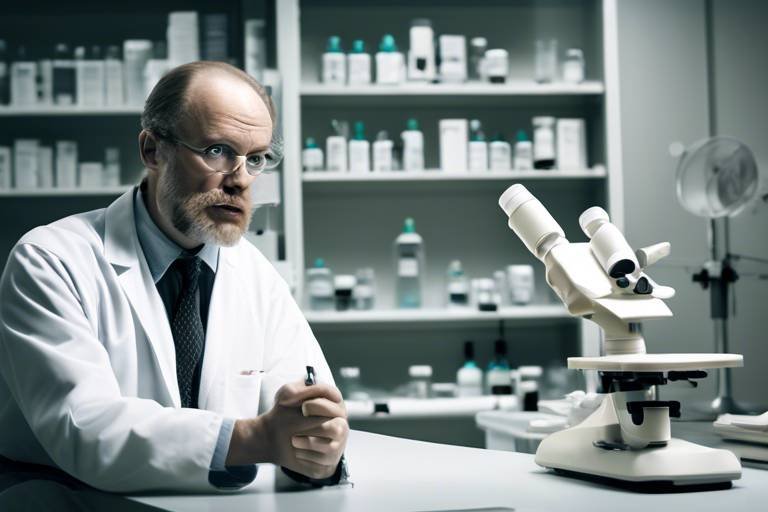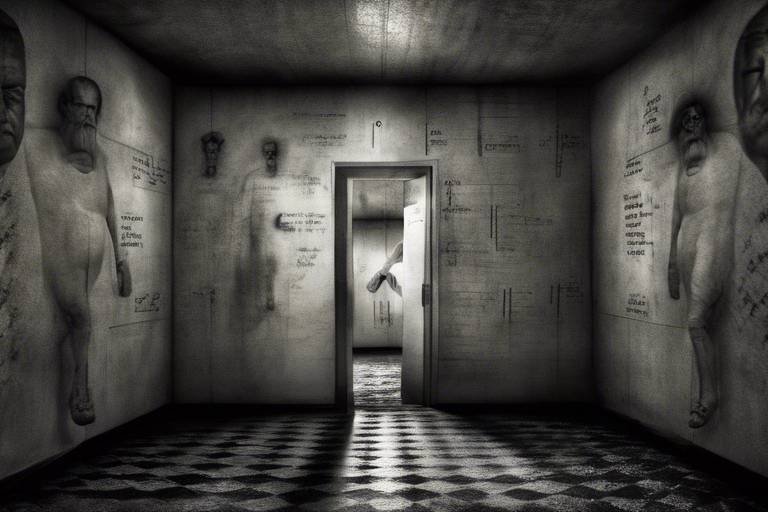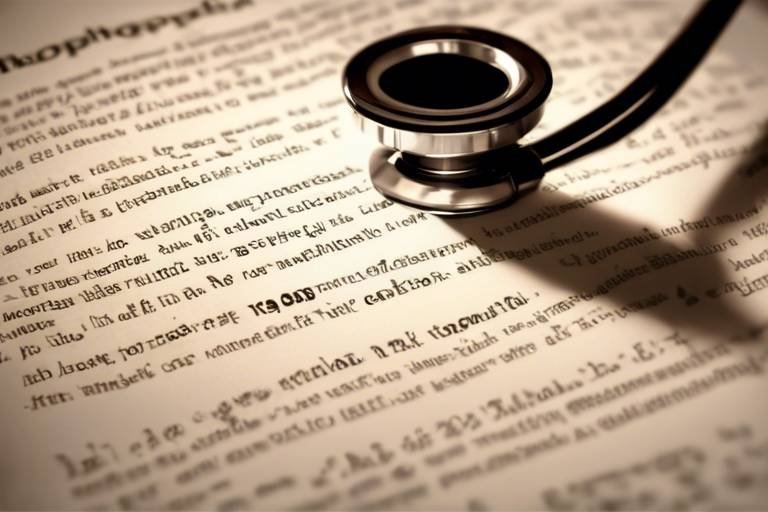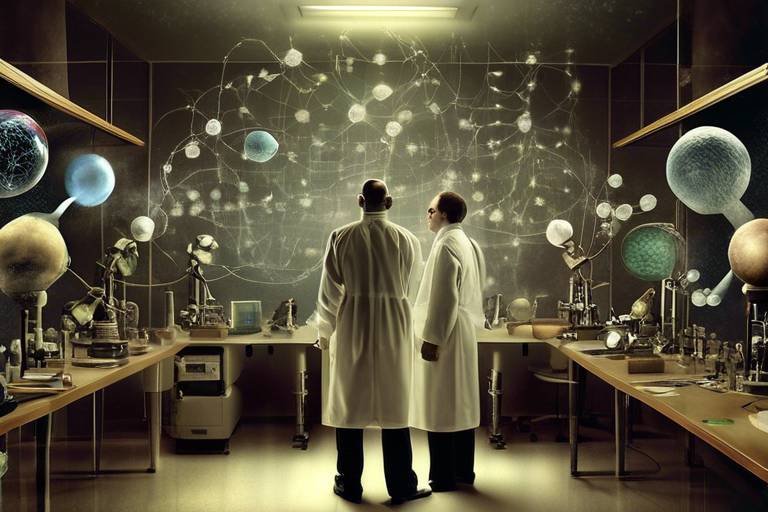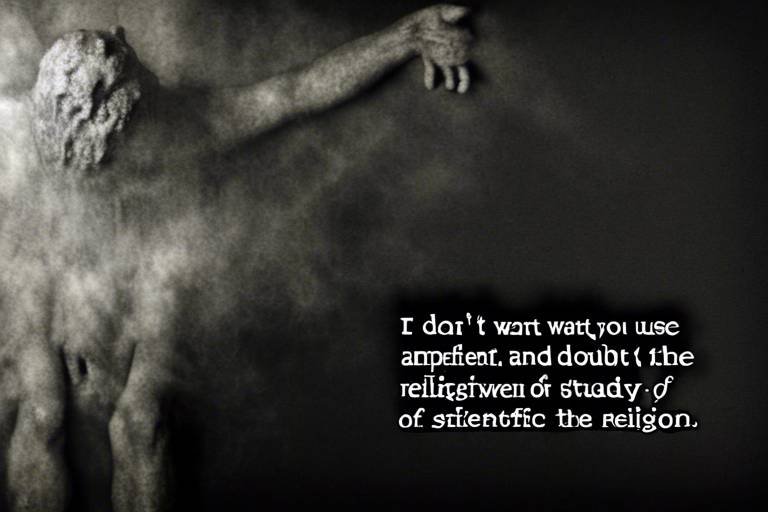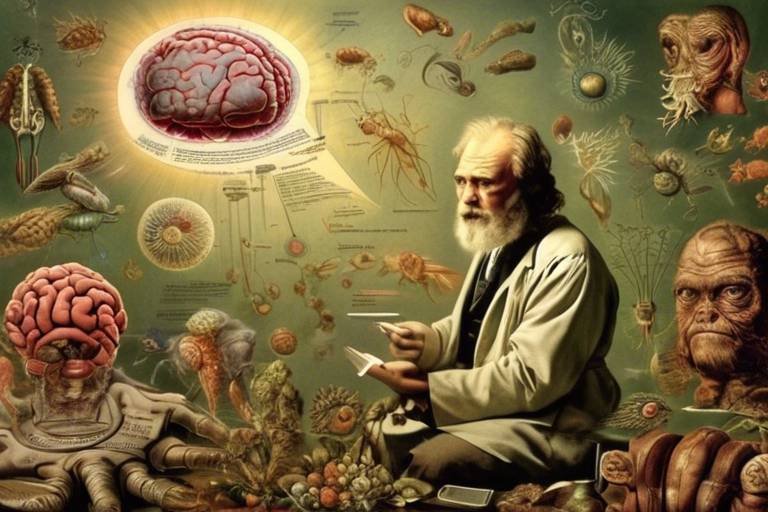The Philosophical Foundations of Forensic Science
Forensic science is like the bridge that connects the meticulous world of science with the often chaotic realm of law. At its core, it embodies a unique blend of philosophical principles that guide practitioners in their quest for truth and justice. These principles not only shape the methodologies employed in forensic investigations but also influence the ethical considerations that arise during the process. When we delve into the philosophical foundations of forensic science, we uncover a rich tapestry of ideas that challenge us to think critically about how we interpret evidence, the implications of our findings, and the responsibilities we bear as custodians of justice.
The journey begins with understanding the role of epistemology, the study of knowledge, in forensic science. Epistemology addresses fundamental questions such as: How do we know what we know? What constitutes valid evidence? These questions are not merely academic; they have profound implications in legal contexts where the stakes are incredibly high. Forensic scientists must navigate the complexities of interpreting evidence while ensuring that their conclusions are reliable and defensible. This interplay between knowledge and evidence is crucial, as it directly impacts the outcomes of legal proceedings and the lives of individuals involved.
Moreover, the ethical dimensions of forensic science cannot be overlooked. Practitioners are entrusted with the responsibility to uphold accuracy and integrity in their work. This means that every piece of evidence analyzed must be treated with the utmost care, as it can have significant ramifications for justice. Ethical considerations compel forensic scientists to reflect on the moral implications of their findings, ensuring that their work does not contribute to wrongful convictions or miscarriages of justice. The weight of this responsibility can be daunting, yet it is essential for maintaining public trust in the criminal justice system.
As we explore the philosophical foundations further, we must also address the impact of bias on forensic evidence. Bias can infiltrate every stage of forensic analysis, from the initial collection of evidence to the final interpretation of results. This can lead to misinterpretations that may unjustly affect the lives of individuals. Understanding the nature of bias and its potential consequences is vital for improving the reliability of forensic conclusions. It prompts us to ask: How can we ensure that our findings are objective and free from personal prejudice?
To combat bias, forensic scientists can implement several strategies aimed at enhancing the credibility of their findings. These include:
- Adopting standardized protocols for evidence collection and analysis
- Engaging in ongoing training that emphasizes awareness of cognitive biases
- Collaborating with interdisciplinary teams to gain diverse perspectives
By recognizing and mitigating bias, forensic practitioners can bolster the integrity of their work, ultimately contributing to a more just legal system. Additionally, examining historical cases where bias has influenced forensic outcomes serves as a critical reminder of the need for continual reform and improvement within the field.
The relationship between science and law is another complex aspect of forensic science. On one hand, forensic scientists strive for scientific accuracy; on the other, they must navigate the legal standards that govern the admissibility of evidence in court. This dynamic raises intriguing questions about the nature of truth in the courtroom. Are scientific truths absolute, or are they subject to interpretation within the legal framework? The answers to these questions are not only philosophical but also practical, as they affect how justice is served.
In summary, the philosophical foundations of forensic science are deeply intertwined with epistemology, ethics, bias, and the science-law relationship. These elements collectively shape the practices and responsibilities of forensic scientists as they work to uncover the truth and deliver justice. As we continue to explore these foundations, we must remain vigilant in our commitment to ethical practices, critical thinking, and the pursuit of knowledge that serves the greater good.
- What is the role of philosophy in forensic science?
Philosophy provides the foundational principles that guide forensic practices, influencing how evidence is interpreted and the ethical considerations that arise. - How does bias affect forensic evidence?
Bias can lead to misinterpretations of evidence, which may result in wrongful convictions and undermine the credibility of forensic findings. - What strategies can mitigate bias in forensic science?
Implementing standardized protocols, ongoing training, and interdisciplinary collaboration can help reduce bias in forensic analysis. - Why is critical thinking important in forensic science?
Critical thinking enables forensic practitioners to rigorously evaluate evidence and make reasoned judgments that withstand legal scrutiny.

The Role of Epistemology in Forensic Science
Epistemology, the philosophical study of knowledge, is a fundamental pillar in the realm of forensic science. It delves into the very essence of how we acquire knowledge and the validity of that knowledge when applied in legal contexts. In forensic science, evidence is not merely a collection of facts; it is a narrative that must be interpreted and understood within a broader framework. This interpretation is crucial because it directly influences the reliability of conclusions drawn in courtrooms.
When forensic scientists analyze evidence, they are not just looking at physical items; they are engaging in a complex process of knowledge construction. They must ask questions like: What does this evidence signify? and How can we be sure that our interpretation is correct? These inquiries illustrate the epistemological challenges that forensic experts face. For instance, the same piece of evidence can lead to different interpretations based on the scientist's background, biases, and the methodologies employed during analysis.
Moreover, the context in which evidence is presented plays a significant role in shaping its interpretation. Forensic scientists must navigate a web of legal standards and scientific accuracy, often finding themselves at the intersection of law and science. This interplay raises critical questions about the nature of truth in the courtroom. Are we merely presenting a version of reality, or are we uncovering an objective truth? The answer is not always straightforward, and this ambiguity can have profound implications for justice.
To further explore the role of epistemology in forensic science, consider the following key aspects:
- Evidence Interpretation: The way evidence is interpreted can vary significantly among different forensic scientists, influenced by their epistemological beliefs.
- Reliability of Conclusions: Understanding the limits of knowledge is essential for ensuring that conclusions drawn from evidence are reliable and justifiable in a legal setting.
- Contextual Factors: The context in which evidence is collected and analyzed can alter its perceived meaning and relevance.
In summary, epistemology is not just an abstract philosophical concept; it is a practical framework that guides forensic scientists in their work. By critically examining how knowledge is constructed and validated, forensic professionals can enhance the integrity of their findings, ultimately contributing to a fairer justice system.

Ethical Considerations in Forensic Practices
When we delve into the world of forensic science, we quickly discover that it’s not just about gathering evidence and solving crimes; it’s also about navigating a complex web of ethical responsibilities. Forensic practitioners are not merely technicians; they are custodians of truth, tasked with the profound responsibility of interpreting evidence that can profoundly affect lives. The ethical dimensions of forensic science demand that professionals maintain a commitment to accuracy and integrity, ensuring that their findings contribute to the pursuit of justice rather than leading to unjust outcomes.
At the heart of these ethical considerations lies a fundamental question: How can forensic scientists ensure that their work is both reliable and impartial? This is particularly crucial in an era where the stakes are incredibly high, and the consequences of errors can lead to wrongful convictions or the exoneration of guilty parties. Forensic professionals must adhere to strict ethical guidelines that govern their practices, including:
- Objectivity: Forensic scientists must approach their work without bias, ensuring that their conclusions are based solely on the evidence presented.
- Transparency: Clear communication of methods and findings is essential, allowing others in the legal system to understand and evaluate the evidence accurately.
- Accountability: Practitioners must be willing to stand by their findings and be open to scrutiny, recognizing that their work has significant implications for the justice system.
Moreover, the ethical landscape of forensic science is continually evolving, influenced by advancements in technology and shifts in societal expectations. As new methodologies emerge, forensic scientists must critically assess how these changes impact their ethical obligations. For instance, the use of DNA evidence has revolutionized forensic science, but it also raises questions about privacy and consent. How do we balance the need for justice with the rights of individuals? This is where the philosophical underpinnings of ethics come into play, guiding practitioners in making nuanced decisions that reflect both legal standards and moral imperatives.
Another significant ethical concern is the potential for bias to creep into forensic analysis. Bias can manifest in various ways, from cognitive biases that affect interpretation to systemic biases that influence the forensic community at large. Forensic scientists must be vigilant in recognizing these biases and actively work to mitigate their effects. This effort not only enhances the credibility of their findings but also upholds the integrity of the entire criminal justice system.
To illustrate the importance of ethics in forensic science, consider the following table that outlines key ethical principles and their implications:
| Ethical Principle | Description | Implications |
|---|---|---|
| Objectivity | Maintaining impartiality in evidence analysis | Reduces the risk of wrongful convictions |
| Transparency | Clear communication of methods and findings | Facilitates trust in the forensic process |
| Accountability | Willingness to stand by findings | Ensures responsibility for errors |
In conclusion, the ethical considerations in forensic practices are not merely theoretical; they are a vital component of the forensic scientist's role. By adhering to ethical principles, forensic professionals can enhance the reliability of their work, contribute to the integrity of the justice system, and ultimately, uphold the values of truth and justice that are foundational to society. As we continue to explore the philosophical foundations of forensic science, it becomes increasingly clear that ethics is not just an add-on; it is a core element that shapes how we understand and apply forensic practices in the pursuit of justice.
Q: Why is ethics important in forensic science?
A: Ethics is crucial in forensic science because it ensures that evidence is handled and interpreted impartially, which is essential for maintaining the integrity of the justice system.
Q: How can bias affect forensic evidence?
A: Bias can lead to misinterpretations of evidence, which can result in wrongful convictions or the failure to convict the guilty, highlighting the need for rigorous ethical standards.
Q: What are some strategies to mitigate bias in forensic analysis?
A: Implementing standardized protocols, ongoing training, and fostering a culture of transparency can help forensic scientists recognize and reduce bias in their work.

The Impact of Bias on Forensic Evidence
Bias in forensic science is a significant concern that can lead to devastating consequences, including wrongful convictions and miscarriages of justice. When we think about forensic evidence, we often envision a cold, hard truth—something that is beyond question. However, the reality is that the interpretation of evidence is not just a scientific endeavor; it is also a human one. This means that the biases, whether conscious or unconscious, of the forensic practitioners can seep into their analyses, influencing the outcomes of cases in profound ways.
Consider this: forensic scientists are not merely machines processing data; they are individuals with their own backgrounds, beliefs, and experiences. These elements can inadvertently shape how they perceive evidence. For example, if a forensic analyst has a preconceived notion about a suspect based on their appearance or background, this bias may cloud their judgment, leading them to interpret ambiguous evidence in a way that supports their initial assumptions. This is where the danger lies—when subjective judgments masquerade as objective analysis.
Moreover, the pressure to deliver results in high-profile cases can exacerbate these biases. Forensic scientists may feel compelled to align their findings with the expectations of law enforcement or the judicial system. This creates a perilous environment where the pursuit of justice can become entangled with personal or institutional biases. In essence, the integrity of forensic evidence is at stake, and the implications can be dire.
To illustrate the impact of bias on forensic evidence, let's take a look at some key areas where bias can manifest:
- Confirmation Bias: This occurs when forensic analysts favor information that confirms their preexisting beliefs, disregarding evidence that contradicts them. It’s like wearing blinders that only allow you to see what you want to see.
- Contextual Bias: The context in which evidence is presented can influence how it is interpreted. For instance, knowing a suspect's criminal history might lead an analyst to view evidence through a skewed lens.
- Expectation Bias: If forensic scientists expect a certain outcome based on preliminary investigations, they may unconsciously alter their analysis to fit that expectation.
Addressing these biases is crucial for preserving the integrity of forensic science. It requires a concerted effort to implement standardized protocols and rigorous training that emphasize the importance of objectivity. Forensic practitioners must be educated about the various types of biases and be equipped with strategies to mitigate their effects. By fostering an environment of critical thinking and self-awareness, the field of forensic science can move towards more reliable and just outcomes.
In conclusion, the impact of bias on forensic evidence is a multifaceted issue that demands attention. As we strive for justice, it is essential to recognize that the tools of science are only as reliable as the hands that wield them. By acknowledging and addressing the biases that can infiltrate forensic analysis, we can work towards a legal system that is truly fair and equitable.
- What is bias in forensic science? Bias in forensic science refers to the influence of personal beliefs, experiences, or external pressures on the interpretation of evidence, potentially leading to flawed conclusions.
- How can bias affect criminal cases? Bias can lead to misinterpretations of evidence, contributing to wrongful convictions and undermining the integrity of the criminal justice system.
- What strategies can be used to mitigate bias? Implementing standardized protocols, providing training on recognizing bias, and fostering a culture of critical thinking are essential strategies to reduce bias in forensic practices.

Strategies to Mitigate Bias
In the realm of forensic science, bias can be a silent saboteur, subtly infiltrating analyses and skewing results. To combat this insidious issue, forensic practitioners must adopt a multi-faceted approach that prioritizes objectivity and integrity in their work. One effective strategy is the implementation of standardized protocols. By establishing clear guidelines for evidence collection and analysis, forensic scientists can minimize the subjective interpretations that often lead to biased outcomes. These protocols serve as a roadmap, ensuring that every step taken adheres to the highest scientific standards.
Moreover, training and education play a pivotal role in bias reduction. Regular workshops and seminars can equip forensic professionals with the tools to recognize their own biases and understand how these biases can affect their work. For instance, exposing practitioners to case studies that highlight the consequences of bias can foster a culture of awareness and accountability. It’s akin to learning to navigate a minefield; understanding where the dangers lie enables one to tread carefully and avoid potential pitfalls.
Another critical strategy involves fostering a collaborative environment among forensic teams. When multiple experts review and analyze evidence collectively, the likelihood of individual biases influencing the outcome decreases significantly. This collaborative approach not only enhances the quality of the analysis but also promotes a culture of transparency and peer review, which is essential for maintaining the credibility of forensic findings in legal contexts.
Additionally, integrating technology into forensic practices can serve as a powerful ally in mitigating bias. Advanced software tools can assist in data analysis and interpretation, providing objective insights that help counteract human error. For example, employing statistical methods can illuminate patterns in evidence that may not be immediately apparent, thus guiding practitioners toward more accurate conclusions.
To encapsulate these strategies, here’s a brief overview:
| Strategy | Description |
|---|---|
| Standardized Protocols | Clear guidelines for evidence handling to minimize subjective interpretations. |
| Training and Education | Workshops to raise awareness of biases and their impact on forensic work. |
| Collaborative Environment | Team-based analysis to reduce individual bias and enhance transparency. |
| Integration of Technology | Utilizing advanced tools for objective data analysis and interpretation. |
By embracing these strategies, forensic scientists can significantly enhance the reliability of their findings, ensuring that justice is served without the taint of bias. In a field where the stakes are incredibly high, such as in criminal investigations, the importance of mitigating bias cannot be overstated. It's not just about the science; it's about the lives that hinge on the accuracy and integrity of forensic evidence.
- What is forensic bias? Forensic bias refers to the influence of personal beliefs, experiences, or external pressures that can distort the interpretation of evidence in forensic science.
- Why is it important to mitigate bias in forensic science? Mitigating bias is crucial to ensure that forensic analyses are accurate and reliable, which directly impacts the fairness of legal proceedings.
- How can technology help reduce bias? Technology can provide objective data analysis, reducing the potential for human error and subjective interpretation.
- What role does training play in bias reduction? Training helps forensic scientists recognize their biases and understand their effects, fostering a culture of awareness and accountability.

Case Studies of Bias in Forensic Science
When we dive into the realm of forensic science, it's essential to acknowledge that the pursuit of justice isn't just a straightforward path paved with facts and evidence. In fact, the history of forensic science is riddled with instances where bias has skewed the interpretation of evidence, leading to devastating consequences. One of the most notorious examples is the case of Brandon Mayfield, an attorney wrongfully convicted of terrorism in 2004 due to a flawed fingerprint analysis. The FBI's initial conclusion was that Mayfield's fingerprint matched one found at the scene of a bombing in Madrid. However, this conclusion was based on a biased perspective, as investigators had already identified him as a suspect without sufficient evidence. This case underscores how preconceived notions can cloud judgment, leading to catastrophic errors in the justice system.
Another glaring example is the Steven Avery case, which gained widespread attention through the documentary "Making a Murderer." Avery was wrongfully convicted of sexual assault and attempted murder, largely due to the biases of law enforcement and forensic experts. In his case, the forensic evidence was mishandled, and the investigators' biases influenced their interpretations, ultimately leading to a conviction based on shaky ground. These instances illustrate that forensic evidence, while scientific in nature, is not immune to the human element, which can introduce bias—an element that can be as dangerous as any weapon used in a crime.
Moreover, the hair comparison analysis scandal in the United States serves as a stark reminder of how bias can infiltrate forensic practices. For decades, forensic scientists claimed they could match hair samples with a high degree of certainty, often leading to wrongful convictions. In many cases, the evidence was presented in court without sufficient validation, and the biases of forensic experts contributed to the misleading testimony that influenced juries. In 2015, the FBI acknowledged that hair comparison evidence was often overstated, resulting in wrongful convictions for hundreds of individuals.
These case studies highlight the critical need for reforms and improved practices within forensic science. They serve as a wake-up call for the legal system to recognize the potential for bias and the importance of maintaining rigorous standards in forensic analysis. By implementing standardized protocols and enhancing training for forensic scientists, we can work towards minimizing bias and ensuring that justice is served accurately and fairly.
In conclusion, the interplay between forensic science and bias is a complex issue that demands our attention. As we reflect on these case studies, it's crucial to ask ourselves: How can we improve the reliability of forensic evidence? The answer lies in acknowledging the past, learning from these mistakes, and striving for a future where justice is not only served but is also seen to be served.
- What is forensic science? Forensic science is the application of scientific principles and techniques to investigate crimes and analyze evidence for legal purposes.
- How does bias affect forensic science? Bias can lead to misinterpretation of evidence, wrongful convictions, and a lack of trust in the criminal justice system.
- What measures can be taken to reduce bias in forensic analysis? Implementing standardized protocols, providing comprehensive training, and fostering a culture of critical thinking can help mitigate bias.
- Are there any recent reforms in forensic science? Yes, many jurisdictions are implementing reforms aimed at improving the reliability of forensic evidence and reducing the risk of bias.

The Interplay Between Science and Law
The relationship between science and law is a fascinating dance, one that can sometimes resemble a waltz and at other times a chaotic tango. At its core, forensic science seeks to uncover the truth behind criminal activities using empirical evidence and scientific methodologies. However, when this evidence enters the courtroom, it must adhere to legal standards that can be rigid and sometimes counterintuitive to scientific inquiry. This interplay raises profound questions about the very nature of truth and justice in our society.
For instance, consider how the legal system often operates on the principle of beyond a reasonable doubt, a standard that can clash with the probabilistic nature of scientific evidence. Forensic scientists might present findings that indicate a certain likelihood of guilt based on DNA analysis or fingerprint matching. However, in the courtroom, the jury must weigh this evidence against their own perceptions of doubt and certainty. This divergence can lead to situations where scientifically sound evidence is dismissed simply because it does not fit neatly into the legal framework.
Moreover, the legal system's reliance on precedent can stifle the evolution of forensic methodologies. While scientific advancements are made at a rapid pace, the law often lags behind, struggling to incorporate new findings or techniques. This can result in outdated practices being used in court, potentially leading to injustices. For example, consider the case of hair comparison analysis, which was once a staple in forensic investigations but has since been discredited due to its lack of scientific reliability.
Another critical aspect of this interplay is the role of expert witnesses. Forensic scientists often find themselves in the position of having to communicate complex scientific concepts to a jury that may lack a scientific background. This communication barrier can lead to misunderstandings and misinterpretations of the evidence presented. To bridge this gap, forensic experts must not only be adept at their craft but also skilled communicators who can simplify their findings without compromising their integrity.
In summary, the relationship between science and law is complex and multifaceted. As forensic science continues to evolve, it is essential for legal practitioners to remain informed about scientific advancements and for scientists to understand the legal context in which they operate. Only through mutual respect and collaboration can we hope to achieve a justice system that is both fair and grounded in scientific reality.
- How does forensic science influence legal outcomes?
Forensic science can provide critical evidence that may lead to convictions or exonerations, making its role pivotal in the legal process. - What challenges do forensic scientists face in court?
Forensic scientists often struggle with communicating complex findings to juries and navigating the legal standards that govern evidence. - Why is it important to understand the relationship between science and law?
Understanding this relationship helps ensure that forensic evidence is interpreted and used correctly, ultimately supporting a fair justice system.

The Influence of Philosophy on Forensic Methodology
The realm of forensic science is not just a collection of techniques and tools; it is deeply rooted in philosophical principles that shape how practitioners approach their work. Philosophy influences forensic methodology in several ways, guiding the processes of evidence collection, analysis, and interpretation. This intersection of philosophy and science raises profound questions about the nature of truth, reality, and the ethical implications of scientific inquiry in the pursuit of justice. Just as a painter uses a palette of colors to create a masterpiece, forensic scientists utilize philosophical frameworks to inform their methods and practices.
One of the most significant philosophical influences on forensic methodology is the concept of epistemology, which deals with the nature and scope of knowledge. Forensic scientists must grapple with questions such as: "What constitutes valid evidence?" and "How can we be certain that our conclusions are accurate?" These questions are not merely academic; they have real-world implications in the courtroom. For instance, the way evidence is interpreted can vary dramatically based on the philosophical lens through which it is viewed. A realist perspective may assert that evidence corresponds to an objective reality, while a constructivist view might argue that evidence is shaped by social contexts and human perceptions.
To illustrate this point, consider the following table that outlines the key differences between two philosophical approaches in forensic science: realism and constructivism.
| Philosophical Approach | Key Characteristics | Implications for Forensic Science |
|---|---|---|
| Realism | Belief in an objective reality independent of human perception. | Emphasizes the importance of empirical evidence and reproducibility. |
| Constructivism | Knowledge is constructed through social processes and interactions. | Highlights the influence of context and subjective interpretation in evidence analysis. |
The implications of these philosophical theories extend beyond mere academic debate; they affect the day-to-day operations of forensic scientists. For example, a forensic analyst influenced by realism may prioritize quantitative methods and statistical analyses to ensure objectivity in their findings. Conversely, a constructivist approach may lead to a more qualitative analysis, considering the broader social context in which the evidence exists. This divergence can significantly impact how cases are approached and resolved in legal settings.
Critical thinking is another philosophical cornerstone that plays a vital role in forensic methodology. It empowers forensic practitioners to rigorously evaluate evidence and make informed decisions. Just as a detective pieces together clues to solve a mystery, forensic scientists must engage in critical analysis to draw valid conclusions from their findings. This process involves questioning assumptions, considering alternative explanations, and recognizing the limitations of their methods. By fostering a culture of critical thinking, forensic science can enhance its credibility and reliability, ultimately serving justice more effectively.
In summary, the influence of philosophy on forensic methodology cannot be overstated. It shapes how evidence is understood, analyzed, and presented in court, impacting the very fabric of the criminal justice system. As forensic science continues to evolve, embracing these philosophical underpinnings will be crucial for ensuring that justice is served fairly and accurately. Just as a compass guides a traveler through uncharted territory, philosophy provides forensic scientists with the guidance needed to navigate the complexities of their work.
- What is the relationship between philosophy and forensic science?
Philosophy informs the methodologies used in forensic science, shaping how evidence is collected, analyzed, and interpreted. - How does epistemology impact forensic practices?
Epistemology addresses the nature of knowledge and influences how forensic scientists determine the validity and reliability of evidence. - Why is critical thinking important in forensic science?
Critical thinking enables forensic practitioners to evaluate evidence rigorously and make informed judgments that can withstand legal scrutiny.

Critical Thinking in Forensic Analysis
Critical thinking is not just a buzzword; it’s the lifeblood of forensic analysis. Imagine you’re a detective piecing together a puzzle where each piece represents a fragment of evidence. To solve this puzzle, you need to look beyond the surface, questioning every assumption and scrutinizing every detail. This is where critical thinking comes into play. It empowers forensic scientists to evaluate evidence rigorously, ensuring that their conclusions are not just plausible but robust enough to withstand the scrutiny of a courtroom.
In forensic science, the stakes are incredibly high. The outcomes of analyses can lead to convictions or exonerations, impacting lives forever. Therefore, critical thinking involves a systematic approach that includes:
- Analysis: Breaking down complex information into manageable parts to understand its components.
- Evaluation: Assessing the credibility of sources and the reliability of evidence.
- Inference: Drawing logical conclusions based on the evidence at hand.
- Explanation: Clearly articulating the reasoning behind conclusions and findings.
Furthermore, critical thinking helps forensic experts navigate the myriad of biases that can cloud judgment. For instance, confirmation bias can lead an analyst to favor evidence that supports their initial hypothesis while disregarding contradictory information. By applying critical thinking, forensic practitioners can challenge their own assumptions, ensuring a more objective analysis. This is crucial in a field where the wrong interpretation can lead to devastating consequences, such as wrongful convictions.
Moreover, the integration of critical thinking into forensic practices is not just beneficial but essential. Training programs that emphasize critical thinking skills can significantly enhance the quality of forensic analysis. For example, workshops that simulate real-life case scenarios can provide forensic scientists with the opportunity to practice their analytical skills in a controlled environment. This hands-on approach not only boosts confidence but also sharpens their ability to think critically under pressure.
In summary, critical thinking is the backbone of effective forensic analysis. It equips practitioners with the tools they need to dissect complex evidence and arrive at sound conclusions. As forensic science continues to evolve, the emphasis on critical thinking will likely grow, ensuring that justice is served based on solid, well-reasoned evidence rather than mere conjecture.
- What is critical thinking in forensic science? Critical thinking in forensic science refers to the ability to analyze and evaluate evidence rigorously to draw sound conclusions.
- Why is critical thinking important in forensic analysis? It is essential because it helps prevent biases and ensures that conclusions are based on reliable evidence, which can significantly impact legal outcomes.
- How can forensic scientists improve their critical thinking skills? Forensic scientists can improve their critical thinking skills through training programs, workshops, and practical simulations that focus on real-life case scenarios.

Philosophical Theories Shaping Forensic Practices
The world of forensic science is not just about collecting evidence and solving crimes; it is also deeply rooted in philosophical theories that guide how practitioners approach their work. Two of the most significant philosophical frameworks influencing forensic practices are realism and constructivism. These theories shape how forensic scientists perceive evidence, interpret findings, and ultimately contribute to the legal process.
Realism posits that there is an objective reality that exists independent of our perceptions. In forensic science, this translates to the belief that evidence can be observed and analyzed to reveal the truth about a crime. For instance, when a forensic analyst examines a blood sample, a realist perspective would assert that the sample contains inherent properties that can be objectively measured and understood, leading to conclusions that are factual and unbiased. This approach emphasizes the importance of rigorous methodologies and standardized practices to ensure that the evidence reflects the truth as closely as possible.
On the other hand, constructivism suggests that our understanding of reality is shaped by our experiences and social contexts. In the realm of forensic science, this theory highlights the subjective elements involved in evidence interpretation. For example, a forensic expert might analyze a fingerprint and arrive at a conclusion influenced by their training, biases, and the specific context of the investigation. This subjectivity can lead to varying interpretations of the same piece of evidence, raising critical questions about the reliability of forensic conclusions. Understanding this constructivist perspective is essential for forensic practitioners, as it encourages them to remain aware of their biases and the potential for differing interpretations within the legal framework.
To illustrate the impact of these philosophical theories on forensic practices, consider the following table:
| Philosophical Theory | Key Characteristics | Implications for Forensic Science |
|---|---|---|
| Realism |
|
Promotes rigorous analysis and accuracy in evidence interpretation. |
| Constructivism |
|
Encourages critical reflection on personal biases and contextual influences in forensic analysis. |
These philosophical frameworks do not exist in isolation; rather, they interact and shape the methodologies employed in forensic science. Forensic scientists must navigate between the two, balancing the objective quest for truth with an understanding of the subjective nature of human interpretation. This balance is crucial, as it impacts the credibility of forensic evidence in courtrooms, where the stakes are incredibly high.
Moreover, the integration of these philosophical theories into forensic practices can foster a culture of continuous improvement. By recognizing the limitations and strengths of both realism and constructivism, forensic practitioners can develop more nuanced approaches to evidence analysis, ultimately enhancing the reliability of their findings. This philosophical awareness not only aids in personal development but also contributes to the evolution of forensic science as a discipline.
Q: How do philosophical theories influence forensic science?
A: Philosophical theories, such as realism and constructivism, shape how forensic scientists perceive and interpret evidence, impacting the methodologies they employ and the conclusions they draw.
Q: Why is it important to understand bias in forensic practices?
A: Understanding bias is crucial because it can lead to misinterpretations of evidence, which may result in wrongful convictions or failures to solve crimes.
Q: What role does critical thinking play in forensic analysis?
A: Critical thinking allows forensic practitioners to rigorously evaluate evidence and make reasoned judgments, ensuring that their conclusions can withstand legal scrutiny.
Frequently Asked Questions
- What is the role of epistemology in forensic science?
Epistemology is essential in forensic science as it helps us understand how evidence is interpreted and the ways in which knowledge is constructed in legal contexts. It addresses questions about the reliability of conclusions drawn from forensic evidence, ensuring that practitioners can make informed judgments that hold up in court.
- How does bias affect forensic evidence?
Bias can have a profound impact on forensic analysis, leading to misinterpretations and potentially wrongful convictions. When forensic scientists allow personal beliefs or external pressures to influence their work, the integrity of the evidence can be compromised, which is why recognizing and addressing bias is crucial.
- What strategies can be implemented to mitigate bias in forensic science?
To combat bias, forensic scientists can adopt standardized protocols and undergo regular training. These measures help practitioners identify their biases and reduce their influence on evidence interpretation, ultimately enhancing the credibility and reliability of forensic findings in legal cases.
- Can you provide examples of bias in forensic science?
Yes! Historical cases, such as the wrongful conviction of individuals based on flawed forensic evidence, highlight the consequences of bias in the field. These cases serve as important reminders of the need for reforms and improved practices to ensure justice is served accurately.
- How does forensic science interact with legal systems?
The relationship between forensic science and law is intricate. Forensic scientists must navigate legal standards while striving for scientific accuracy. This interplay raises significant questions about the nature of truth in the courtroom and emphasizes the importance of clear communication between scientists and legal professionals.
- What philosophical theories influence forensic practices?
Philosophical theories such as realism and constructivism play a significant role in shaping forensic methodologies. They guide how forensic scientists collect, analyze, and interpret evidence, ultimately affecting the overall practice of forensic science and its application in the legal system.
- Why is critical thinking important in forensic analysis?
Critical thinking is vital in forensic science as it empowers practitioners to rigorously evaluate evidence and make reasoned judgments. This skill is essential for ensuring that conclusions can withstand legal scrutiny and contribute to fair outcomes in the justice system.






